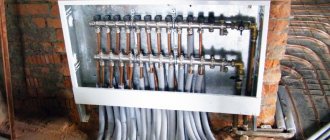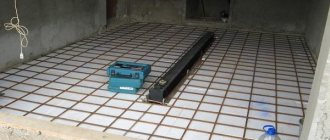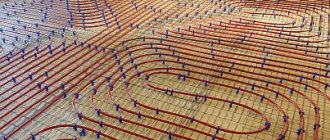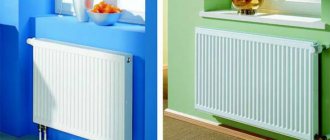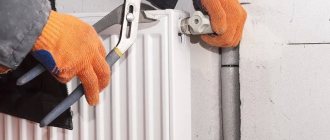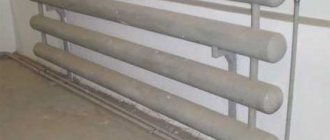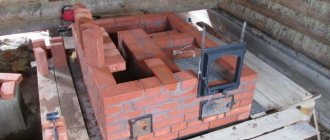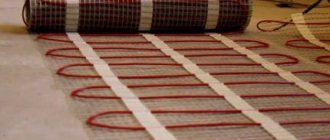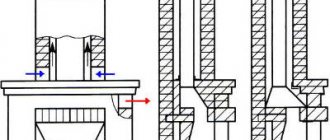Here you will learn:
- What is baseboard heating?
- Varieties
- Advantages and disadvantages
- DIY installation work
The popularity of baseboard heating is gradually growing. It is characterized by extreme compactness and is not striking when compared with classic heating systems. Let's see how to make a warm baseboard with your own hands and what you need for it. Some sources state that the system will only achieve maximum efficiency if it is assembled by a specialist. But in reality this is far from the case. The main thing is to have a set of tools and straight hands.
Installation Features
When deciding to install a heating device, you don’t have to resort to the services of specialists.
Installing a warm water baseboard with your own hands will not be difficult. Before starting work directly, it is necessary to study the diagram, as well as carry out the necessary calculations and measurements. You should prepare all the necessary tools: adjustable wrenches, pliers, wire cutters, sharp scissors, a hammer and a drill. To install the plinth, you will need thermal boards, as well as additional components. The latter include:
- connecting adapters for various sections and plastic pipes;
- pipes for connection;
- rotary corner pipes;
- protective pipes are red and blue.
Don't forget about the pipe rotation angles
Installation of the water baseboard should be carried out strictly following the instructions. Its installation diagram looks like this:
- Pipes are laid, with the distribution manifold serving as the starting point.
- The distance between the collector connection point and the baseboard itself is measured.
- The pipes are adjusted in size according to the measurements obtained and laid into the wall so that the blue icon is on top and the red icon is on the bottom.
- The place where the plinth is mounted is covered with self-adhesive tape.
- Installation of the aluminum profile starts from the corner.
- The profile is attached to the wall using self-tapping screws or silicone.
- It is necessary to move 15 cm away from the corner, drill holes for the dowels and install the clips at a distance of 40 cm from one another.
- To install convectors, plastic pipes must be adjusted so that they are attached to the baseboard section as accurately and firmly as possible.
- To install the coupling correctly, you need to put a nut and bushing on each pipe and provide them with a rubber gasket.
- A sleeve must be inserted into the plastic pipe for support.
- An adjustable wrench is used to twist the pipes.
- The thermal board is applied to the wall, the number of brass ribs is adjusted (extra ones can be removed using wire cutters).
- The next section is connected using an adapter. During installation, you should make a 1 cm indent under the decorative elements.
- At corners, special corner pipes should be used that follow the shape of the corner. They are installed similarly to pipe connections using bushings, nuts and gaskets.
- The final section is corrugated stainless steel, fastened in a similar way to other couplings.
- The plinth cover is attached as follows: its inner surface is covered with electrical tape, applied to the profile and snapped into place with clips.
- At this stage, decorative plastic plugs and corner joints are installed.
- The last step is to connect to the collector and start the water.
Installation of electric warm baseboard:
Preparing tools
Also, to install the structure we will need a set of additional tools. They are not included in the basic kit, so every master should have them. To work you will need:
- Hammer.
- Pliers and wire cutters.
- A knife capable of cutting plastic pipes. It can be replaced with scissors that can cope with a similar task.
- Hammer or drill for drilling holes for dowels. Drills of the required diameter.
- Screwdriver.
- Spanners.
Attention! Some tools require minimal skills to operate them. If you are not confident in your abilities, we recommend not to take risks and entrust the installation of the system to professional workers
Device and technical features
Externally, the heating device looks unremarkable: it is a long baseboard no more than two tens of centimeters wide.
The design of the device includes:
- radiators made of brass in the form of thin plates, they warm up and give off heat to the air;
- a module containing coolant, pipes through which the liquid circulates;
- decorative closing panel with a slot for the passage of heated air;
- rear strip protecting the wall from the high temperature of the heater.
The operating principle of the heater is very simple. The water is heated in the system’s boiler, then the heat is distributed through the pipes around the entire perimeter of the room. The heat flow moves from the floor to the ceiling, uniformly heating the entire space of the room. Heat flows along the walls, warming their surface. The wall also begins to release thermal energy to the air.
The coolant in the baseboard can be heated up to 70 degrees, but maintaining such a high temperature is not recommended due to possible damage to the walls and their decorative coating. The optimal temperature of radiators is about 40 degrees. This indicator will ensure uniform heating of the air in the room to a comfortable temperature of twenty-four degrees.
Material of manufacture
Shower stand: materials
Traditionally, corrosion-resistant materials are used for the manufacture of shower bars - stainless steel, brass, polymer compounds. Rods made of brass are considered the most reliable: they are durable, strong, do not emit harmful substances, and are also easy to maintain. Since brass is quite heavy, the rod must be fastened appropriately, otherwise the entire structure, together with the watering can, may fall off at once and damage the bathtub.
Shower system with rain shower "umbrella" for shower enclosure
Stainless steel is slightly inferior in technical characteristics to brass, although it also has fairly high strength and does not corrode. Steel products have less weight, so they can be attached to any base, including light partitions.
Stainless steel rod
Rods made of ABS plastic are among the most budget options. They tolerate temperature changes well, do not rust, do not emit harmful substances, and look quite attractive. For greater aesthetics, the plastic surface is coated with a thin layer of chrome or nickel. Plastic rods are very light, and therefore can be attached not only to dowels, but also to suction cups.
Metal-plastic shower bar rotating with soap dish
Aesthetic shower organizer
What is the design of a warm baseboard
As you can guess from the name, this design is very similar to a regular baseboard. The external collapsible box is made of durable materials; its width is about 3 cm and its height is 14 cm. Inside it, a coolant (water or an electric heater) is placed on specially designed holders.
A warm baseboard is laid around the entire perimeter of the room or along one massive wall. It heats the walls, which in turn reflect heat into the room. This thermal radiation provides comfortable and uniform heating, and also has high efficiency. But it should be remembered that the wall must have good thermal conductivity: so, next to wooden walls, a warm baseboard will be ineffective.
Warm skirting boards will perform best along damp and cold walls, in rooms with panoramic glazing (for example, in a greenhouse, insulated balcony), in apartments with high ceilings. You can place them at the head of the bed or next to your workspace by the window. They are installed in a swimming pool, in a store, in an office.
Standard indicators
The standard installation, which is manufactured in a factory, has a power of 240 watts. This is the optimal indicator for a room whose perimeter is approximately twenty meters (taking into account the average ceiling height).
Frequently asked questions concern the possibility of making such a radiator yourself. In principle, it makes sense to do this yourself, but you need to be prepared for the fact that the process will take a lot of time, effort and finances. In some cases, such an experiment turns out to be more expensive than buying a ready-made warm baseboard.
Baseboard heating is comfortable, beautiful, economical
A radiator heating system and heated floors are not the only way to heat a room. Recently, warm baseboards have become increasingly popular. This type of heating appeared on our market only a few years ago and there is not much experience in its operation yet. However, it is quickly gaining popularity - it is the most discreet and very comfortable type of heating.
Warm baseboard - small heaters located along the floor around the perimeter of the room. They are named so because of their location and size: the thickness of such a heater is 2.5-3 cm, which is comparable to the size of a standard floor plinth. The height is greater: 12-15 cm, but everything looks organic
What is important: such a system does not limit the installation location of furniture and decorative items, since heat is transferred not by convection, but by radiation
This is what baseboard heating looks like. No more other heating devices
Heating baseboard: its positive qualities
During the cold season, you really want your home to be warm and cozy. Central heating cannot always cope with this situation, so we often resort to other effective means by installing additional heating equipment in the house.
Heating baseboard is one of the types of heating that will warm the room and allow you to enjoy the warmth and comfort of your home. This heating method can be used either independently or together with other heating devices.
The warm baseboard is compact and does not take up much space in the house compared to other devices. This plinth is easy to install, since its design is very convenient, you can do it yourself.
A warm warm baseboard has many advantages
The main advantages of warm baseboards:
- Compact;
- Effective;
- It is easy to install and repair;
- Heats the room well from all sides;
- Does not dry out the air in the house;
- Its appearance is aesthetic;
- Has any colors.
The heating baseboard heats not only the floor, but also the walls, which prevents the formation of mold and mildew. It can be of different colors, so it fits into any interior. Its design is compatible with any floor covering, be it carpet, linoleum or wooden parquet.
Baseboard heating
Despite the fact that in our country what a warm baseboard is became known not so long ago, in Europe premises have been heated using this method for several decades. This technology is very simple, but at the same time quite convenient. The basis is metal (most often copper) pipes, which are also the heating element. The pipes are installed in the same place where the baseboard usually runs, that is, along the perimeter of the room. Then they are covered with a metal box made of plates with a corrugated surface. Due to this design, the box acts as a heat exchanger, thereby increasing the efficiency of the structure.
In general, a water baseboard consists of the following elements:
- front panel with holes that ensure air flow (standard size: width - 3-4 cm, height - 15-20 cm);
- rear panel - facilitates installation of the structure and protects the wall from constant exposure to high temperatures;
- heating radiator that performs the heating function (standard dimensions - 1 m x 0.4 m x 1.6 m);
- rotating side plugs;
- a heat exchange module consisting of two tubes through which water circulates.
Due to the fact that the baseboard is installed around the perimeter of the entire room, the heat gradually rises, and then the entire room is evenly heated. As a result, this technology does not cause temperature changes. Since the heating element is hidden under the front panel, it is not noticeable, which distinguishes it from massive radiators. As you can see in the photo, the warm baseboard looks very neat; it can be additionally decorated so that it better matches the overall style of the room. The system is effective, but at the same time quite simple to install. Having minimal skills, you can carry out installation without involving professionals.
Scope of application, prices, manufacturers
You can install a baseboard heater in any room for any purpose. There are special models for high humidity conditions. From a design point of view, they are almost ideal: they do not spoil the interior and do not attract attention. It feels very comfortable to be in such a room: the air is fresh and there are no foreign odors.
There is only one feature: they are effective in homes with permanent residence. At a minimum, with constant heating at low temperatures and periodic increase to a comfortable level. The fast heating mode is not their area of application: the power is low. Requires long heating time.
There are both European and domestic manufacturers on the market. With prices and quality as usual: Europeans have beautiful, reliable, expensive; Domestic ones are cheaper, but worse made. And the difference is not only in appearance. This is often more or less normal. The problem is the occurrence of creaks and clicks in the system during sudden heating and cooling. This problem is typical for the connection of two metals: different temperature expansion provokes the occurrence of this effect. Europeans have been producing such equipment for decades and have learned to deal with it. Ours don’t know how yet. So this is the feature. Based on this, whenever possible, install warm baseboards from trusted and venerable manufacturers in your bedrooms.
There are models with copper plates. They have very high heat transfer and corresponding prices
By names and countries of manufacturers something like this:
- Chemo Thermboard - Austria
- Best Board Austria
- Termaskert - England
- Thermia - Ukraine
- Aurora - Ukraine
- Mr. Tectum - Russia
- KZTO - Russia
How to make a warm baseboard with your own hands
Even if made in Russia, this pleasure is not cheap. But what if you want to try such a system, but don’t have a lot of “extra” money? Do it yourself. There are two working options.
Option one
Unannealed copper pipes with a diameter of 12 mm and roofing copper sheets 0.4 mm thick were used. The order of work is as follows:
- Cut a strip of roofing copper (60 cm) with a grinder into strips of 15 cm.
- The edges of the full length strips should be beaded at an angle of 90 o and the flange length is 7-8 mm. The length of the strips is no more than 3 meters - it is inconvenient to work with large pieces.
- Solder copper tubes to the back side of this plinth. To do this you need solder (plumbing solder containing 3% copper) and a torch. When soldering, point the torch at the tube: the strip is thin and will warp if overheated. The tube can withstand heat normally.
- Bend the ends of the tube slightly before soldering. This will make it more convenient to put adapters on them.
- For assembly, oil and petrol resistant hoses were used that can withstand working with coolant up to 120 o C (internal diameter 12 mm). At the connection points with the pipe they were secured with ordinary clamps.
- To regulate the temperature, a manually adjustable thermostat is installed.
- The joints are covered with similar inserts/plinths made of copper, but without pipes.
- The panels are attached directly to the wall using standard mounting clips (by the pipes). Do not insert them into the recesses - most of the heat is lost.
This system has worked in a wooden house for 9 years. There were no problems or need for repairs. The coolant temperature at the inlet is from 50 o C to 70 o C. In the room, 20-21 o C when increased is too hot.
Watch the video about the features of installing warm baseboards. May be useful.
Second option
In this case, aluminum profiles for working with drywall were used to make a warm baseboard with your own hands. Holes are cut (sawed) in them with a grinder at the top and bottom, after which they are attached to the walls. Two copper pipes are laid on a thin aluminum ceiling profile, screwed with aluminum wire. This entire structure is laid inside and fixed to the wall so that the pipes are one above the other. The pieces of such a homemade plinth were assembled by welding with copper pipes and fittings. “Front panel” is the same profile, only painted with radiator paint to match the walls (floor). This homemade warm baseboard is less effective and more difficult to clean, but it is also very functional.
“I have a baseboard like this at home. In addition to heated floors. I advise you to install it too. The warm baseboard does its job well. Of course, it cannot be compared with warm floors in terms of power, but still there is noticeable warmth from it.”
“I bought a Megador 600 W for a 9 m2 bedroom. At first it worked at full power, but now we set it to maintain 20 degrees at 200 W. This is enough for my area, we don’t need a higher temperature, we don’t like it. And at the same time, on the wall where the heater is located, our ventilation hole is almost always slightly open. I'm happy."
As you can see, reviews about warm baseboards are positive. This is no wonder: the heating is efficient, comfortable, and even invisible. The only thing that spoils the picture is the high price, but there are options for making it yourself.
Like everything new, the plinth system has many critics and theorists. Their main thesis: “It’s stupid to heat walls and then heat the air. It’s better to heat the air directly, and then start heating the walls.” The point of view is clear. This is what is used for convector heating. But the result and its shortcomings are known to everyone. And for the efficiency of heating the walls, an experiment was carried out: in one room the air was +12 o C, and the walls were heated to +37 o C. And the people in it were sweating. In another, the air was heated to +40 o C, and the walls were cooled to +12 o C, and people were freezing.
Practical advice
Installation of a warm baseboard
1. Remember that your warm baseboard should heat the air along the wall, but not the wall itself!
Therefore, edge the wall in those areas where the baseboard heater will be located with insulator: strips of thicker plywood or plasterboard. 2. It is important to correctly cut out the future radiator fins from a sheet of brass. In order for them not only to serve as emitters, but also to become load-bearing brackets, they must be made in the form of the letter “P”, to the crossbar of which you will screw the aluminum frame strips with self-tapping screws. The lower part of the legs of this “P” must also be bent at a right angle outward: this way you will make platforms for attaching the brackets to the wall (more precisely, to the strip of plywood that you previously installed on the wall).
Thus, you receive the initial data for the pattern: plate height - 16 cm; the width is: 12 cm (two thicknesses of the plinth) + 3 cm (the width of the crossbar between the legs) + 6 cm (the total thickness of the two “bends” for attaching to the wall). Total – 21 cm.
Are there any other options for heating a balcony? The article “Do-it-yourself warm water floor on a loggia - step-by-step instructions” will help you make a warm water-heated floor on your balcony yourself. Which warm floor for a balcony is better: water or electric? An analytical review on our website will help you solve this issue. Read about the installation of an electric heated floor on a balcony here: https://oknanagoda.com/balkony-lodzhii/remont-otdelka/teplyij-pol-na-balcone.html
Blank for a warm baseboard radiator fin
You have a plate of 16x21 cm. Draw the horizontal and vertical axes of symmetry on it - it is best to use a measuring compass needle for this.
Step back 4 cm up and down from the horizontal axis of symmetry and draw two more parallel lines.
Step back from the vertical axis of symmetry 4.5 cm to the right and left and draw two vertical lines. At the intersection points of these additional lines you will get the centers of the holes through which the pipes will pass. They need to be drilled out.
3. To drill holes for pipes, you need to take a drill 0.5 mm larger in diameter than the diameter of the tube you purchased. But it won’t be a big deal if the drill is 1mm or 2mm larger. 4. After drilling the holes, the brass plate must be bent in the form of a U-shaped profile with bends of the “legs” for fastening to the wall. For this it is also worth making markings.
Read about how to install heating on a balcony or loggia in the advice of experienced people on our website. Also learn about the possible legal consequences of removing heating on a balcony. Read about the general rules for the safe operation of balconies here: https://oknanagoda.com/balkony-lodzhii/yuridicheskie -voprosy/pravila-ehkspluatacii-balconov.html
Step back 3 cm from the sides of the plate and draw two vertical lines at this distance. You will use them to bend the bends to attach the radiator to the wall.
This is how you bend brass in a vice
Step back from the vertical axial line 1.5 cm to the right and left and also draw two parallel lines: they will mark the boundaries of the “crossbar” of the letter “P”.
5. Bending brass is as easy as shelling pears: clamp it in a vice so that the bend line coincides with the upper edge of the jaws of the vice, and, successively drumming with a hammer (preferably copper, not steel) along the bend line, bend the plate until its free edge will lie on the jaws of the vice. You will not be able to achieve a more right angle at home. 6. Now screw the radiator brackets with self-tapping screws or screws to the plywood (drywall) with which you edged the wall at the location of the baseboard heater. And insert the copper pipes you have stored into their holes. Your original baseboard heater is assembled.
Important! Drywall does not hold screws, screws, or any other fasteners that we try to install into it. Therefore, immediately, before installing the pipes, place a support under the brackets. For example, a rail of suitable thickness. Secure both tubes every 1.0-1.5 m with clamps using dowels, which should be driven into something more permanent than drywall: the wall of a house, a backfill in the lining of a balcony, etc.
7. How to loop the circuit and connect it to a hot water source?
Looping a contour
It's good to have fittings for this case. It is good to be able to correctly make an insert into a central heating pipe. But, in principle, all this is the concern of the home plumber, and not the heating engineer.
In practice, it was possible to observe how heating systems for years were fed through an ordinary corrugated hose, and even through a rubber hose, put on the flared end of a copper tube and tightened with a clamp.
Using the same fittings and hoses that you used to connect your warm baseboard to the heating system, loop its circuit. That is, connect the “back ends” of the copper tubes with a corrugated hose or some other method so that water flows freely from one tube to the other. And from that - back to the central heating system.
Important! Do not be deluded by the thought that you will be able to bend a copper pipe at home with high quality. Theoretically, it must first be tightly filled with fine sand, the ends plugged and bent, twisting around a steel column of a certain radius. But in practice, it is not realistic to tightly fill a tube with a diameter of 16 mm and a length of 2 m with sand. And when you try to wrap it around the metal leg of a stool or something similar, you will either break the tube or crumple it so much that at the bend its capacity will decrease and, sooner or later, cracks will appear in this place and the system will begin to leak. Therefore, do both the looping of the contour and the outlining of the corners (if you are laying the system along the entire perimeter of the room) using hoses, and not by bending the pipe.
8. The thermal conductivity of aluminum is much worse than the thermal conductivity of copper. The aluminum casing in which you pack your “warm baseboard” is also a screen that drives warm air up along the wall. Therefore, it is worth leaving a 5-10 mm wide gap on the upper plane of the box, through which heated air will flow along the wall.
Advantages of using warm baseboards
The use of such a modern heating system provides many advantages for consumers, namely:
- the ability to save free space due to its compact size, which is very important for small rooms;
- creating comfortable conditions for all living things in a heated room. The warmth of the baseboards provides an optimal microclimate for humans, animals and plants. Especially warm plinth is suitable for corner apartments, where, if used, the walls will be completely warmed up and thus you can forget about the fungus;
- no condensation on the windows and uniform heating of the entire room;
- due to the absence of convection currents, as with traditional heating, the level of dust in the room decreases;
- high efficiency at work;
- absolute safety and ease of operation;
- ease of installation and the ability to fit into any interior due to the variety of designs and color schemes;
- energy savings, which is approximately 40%;
- affordable price.
Pros and cons of the system
Almost invisible
- A warm baseboard system resembles a warm floor, but its installation requires much less cost and effort. In addition, heated floors, especially water-based ones, cannot be installed in every room due to the need to create a concrete screed. The plinth has no such restrictions; for its installation you only need a flat wall. The modular system is mobile; if necessary, it can be dismantled and moved to another location.
- With the help of a warm baseboard, a favorable microclimate is created in the room; slow rising air currents do not raise dust. The temperature in the room will not be high near the ceiling and low near the floor.
- Warming up the walls will forever get rid of dampness and mold in the room; when installed in rooms with large glazing, condensation on the windows disappears.
- The small cross-section of the tubes requires a small volume of water, and this reduces the cost of heating it. The coolant circulates in an accelerated mode, which reduces heat loss in the system by up to 5%. A small amount of water eliminates inertia when it is necessary to change the temperature; all adjustments are made in a short time. Electric baseboards provide savings not due to the coolant, but due to lower energy consumption.
- The low temperature of the heating device results in savings on energy costs. Separate controls in each room allow you to choose the optimal temperature.
- Installation of skirting boards is not difficult, since they consist of ready-made modules that are connected to the power supply or heating system.
- The low temperature of the heating device is safe for furniture, curtains and other objects located nearby.
- The installed baseboard system is almost invisible - it will harmoniously fit into any stylistic design of the room; the color of the aluminum protective panels can be easily matched to the surrounding interior.
Uniform heating
Disadvantages include the high initial cost of a warm baseboard and energy costs when installing an electric baseboard. The peculiarity of its use is the need for constant operation. The low power of a warm baseboard is not designed to quickly warm up the room; it takes time to heat the walls, which will then give off heat.
Water warm baseboard
Particular comfort in residential premises can be created by assembled warm water baseboard with your own hands. If we look at the water plinth from a constructive point of view, we will see compact modules “stretched” in length.
Private households or public institutions are most suitable for installing baseboard water heating systems. The necessary conditions for installing warm baseboards are the presence of a gas boiler and a central water supply.
In some cases, boilers operating on solid and liquid fuels are used. You will also need a reserve tank (water tower) to replenish the water level in the heating system.
Skirting convectors with water coolant are installed around the perimeter of the room. The modular liquid electric heater can be of various lengths. In the corners of the room, the modules are connected with special corner elements, thereby filling the completely heated perimeter of the room. Thanks to this placement of baseboards, the room is heated more evenly than when heating with conventional water radiators.
Otherwise, you may be fined and forced to dismantle the heaters.
Water converter design
The design of the plinth is quite simple. The upper pipe, as a rule, exits the gas boiler system, passes through the entire perimeter of the heated area and passes into the lower return pipe. The lower pipe returns the cooled coolant to the gas boiler.
The pipelines are mounted in the housings of finned heat transferrs. Due to the ribbed structure, the heat transfer surface increases many times over, which significantly contributes to the active circulation of heated air masses.
To install a warm water heating baseboard yourself, you must have sufficient experience in installing plumbing equipment. When we talk below about the features of installing a warm water baseboard, we are addressing precisely such people. This will help when choosing a particular home heating system.
The principle of operation of water skirting boards
Cold air enters through the lower groove of the baseboard body.
Passing through the heat exchanger, the hot air slowly rises, spreading evenly throughout the entire volume of the room.
Installation of baseboard water heating system
In construction supermarkets you can always purchase the ready-made water heating system for baseboards you need. Having even a little experience in plumbing work, you can easily make a warm baseboard with your own hands. heating with warm baseboards, watch this video:
After appropriately marking the mounting points for the brackets and installing them, the liquid modules themselves are installed (see installation of electric baseboards above). Unlike electric heaters, installation of liquid modules requires careful monitoring of the tightness of pipeline connections.
Testing of installed skirting boards
Air molecules are much smaller than water molecules. Practice shows that checking the tightness of connections is more effective by creating high pressure of compressed air inside the pipelines.
Bubbles will appear in areas where leakage occurs. Leaks in connections are eliminated and the entire system is retested for leaks.
Operating principle and differences
Manufacturers of baseboard heating claim that the system is more economical than all other types of heating. Savings are 20-30%. This happens because lower temperatures are required to achieve a comfortable feeling. This is because most of the heat is transferred by radiation rather than by convection.
Almost all existing heating systems do not create the best thermal picture: warm air accumulates at the top, while cold air remains at the bottom. If the room does not have very high ceilings, the situation is tolerable, but in rooms with large heights this is critical. To equalize the temperature picture, forced convection is used: fans are built into heating devices that more or less effectively mix the air masses. But active air movement carries dust and germs. At the same time, stagnant zones still remain in the corners of the rooms, in which cold air accumulates.
When using baseboard heating there is no thermal cushion at the top, the air is fresh and the feeling is comfortable
Uneven temperatures and dust in the air are not all the troubles of convection heating. There is also dampness that appears on the walls. The fact is that convection heats the air. The walls remain cold. When warm air comes into contact with cold walls, condensation occurs, the walls become wet, and fungi and mold develop. Moreover, this picture is typical for houses and apartments with good insulation.
Baseboard heating works differently
The first important difference: the lower layers of air immediately heat up, which is already comfortable. Gradually and slowly rising up along the walls, the air cools, transferring heat to the walls
Therefore, it turns out that the top is not warmer (or not much warmer) than the bottom.
Only about 20-30% of the heat is spent on heating the air by convection. Everything else goes to heating the walls
And this is the second important difference. Heated air rises along the walls, rather than mixing with the rest (this effect was noticed by the scientist Coand)
Therefore, the rising warm flow cuts off the cold from the walls and heats them. Yes, while the walls heat up and dry out, a lot of energy (and fuel) is consumed. But after that the entire surface begins to radiate heat.
This is where the savings zone begins: a person feels comfortable if the wall temperature is 36-37 o C and the air temperature is 16 o C. We simply feel the heat emanating from the walls with the entire surface of the body. At the same time, the cost of maintaining the temperature of dry walls is low. After all, it is the water contained in the materials that is the best conductor of heat, and the air that replaces it, on the contrary, conducts heat poorly.
This is what one of the options looks like up close
That is why with such heating it is not so important whether there are pieces of furniture along the walls or not: it is mainly the walls that are heated, not the air. Let them take away some of the heat, but then they themselves will begin to give it back
But the walls will heat up anyway.
What systems are used today for heating rooms?
Objects for various purposes must be warm. This is necessary for normal human life. Not only in residential, but also in office, warehouse, industrial, and public premises, various types of heating systems are installed for this purpose.
Heating battery in the interior
Heating can be:
- air;
- water;
- electrical;
- stove.
Classification of the main types of heating systems
A set of equipment usually consists of several main components:
- heat generator;
- heating devices (radiators, heaters, convectors, etc.);
- communication systems (it includes electrical cables, pipelines, air ducts, etc.).
Centralized networks or your own equipment (for example, a boiler) can be used as a source of coolant.
Heating scheme with electric boiler
The most common types of space heating today are air and water.
Prices for Ballu convectors
Convectors Ballu
Air heating
In this case, the air is heated directly.
Air heating at home
Such heating can be organized in different ways:
- using natural or forced circulation of air masses;
- through suspended or floor-mounted equipment;
- direct-flow, recirculation or combined heat exchange.
Air systems can be installed both in private buildings and at large facilities.
Such equipment can be used in private homes
Air heating is a complex structure consisting of a heat source (they can operate on different types of fuel), an air duct network, fans, air distributors, filters, regulators and automation.
pros
- The heating of air masses and the creation of comfortable conditions for living occur within a short period of time.
- System efficiency and efficiency are at a high level.
- It is possible, in addition to the main task, to arrange air conditioning and ventilation of rooms.
- There is no need to use water (or other liquids) as a coolant (hydraulic systems often become a source of problems).
- When using suspended equipment layouts, it is possible to save usable space.
- You can install air heating with your own hands.
Minuses
- Calculating the parameters of system components is not so easy.
- To ensure a normal level of humidity in the room, it is necessary to additionally install devices for humidifying air masses.
- It is often not possible to modernize the system.
- The equipment may be noisy when operating.
Air heating of industrial facilities
Expert opinion
Afanasyev E.V.
Chief editor of the pol-exp.com project Engineer.
Despite some disadvantages of this method, it is considered quite competitive in comparison with the more traditional - water method. And if earlier air heating was more often used in industrial facilities, today many private property owners are inclined to install such systems in their houses and apartments.
Prices for Volcano water fan heaters
Volcano water fan heaters
Water heating
The method of heating the surrounding space by transferring heat from its source through a water system is one of the most popular. Liquid is still the most common coolant. The equipment includes a heating unit, a main network, heating devices, and devices for controlling heat transfer. Pipeline routing can be top, bottom, horizontal, vertical or combined , while communications can sneak in in a hidden way (hidden behind the cladding) or be in plain sight. Constant and variable hydraulic modes, natural and artificial fluid circulation are used. Systems can be one-, two-, three-, four-pipe, manifold or combined.
One- and two-pipe systems
Today, water-heated floors are also increasingly being installed (in autonomous structures).
pros
- Low cost of equipment.
- Possibility of temperature control.
- The use of pipelines with a smaller diameter (when compared with air or steam analogues).
- No noise during system operation.
Minuses
- Due to the inertia of the system, heating and cooling do not occur as quickly.
- The uninterrupted operation of the heat source must be monitored.
- It is better not to leave operating equipment unattended. In this regard, in winter, if there is a need to leave the house for a long period of time, the water has to be drained.
- Installing water heating is not so easy.
- After draining the water, air pockets may form. Metal elements of the system are subject to corrosion.
Recently, underfloor heating has become increasingly popular.
Water heated floor
Using this method, it is possible to create a comfortable microclimate without installing heating devices. In addition, the entire system is hidden from view. In this case, the pipeline network is filled with a concrete screed, on which the floor covering is laid. The coolant (liquid) circulates through the pipes and heats the floor, which becomes the heating device.
Expert opinion
Masalsky A.V.
Editor of the “floor screed” category on the Pol-exp.com portal. Engineering systems specialist.
However, it should be noted that radiators, convectors, and heated floors, among other things, have a common drawback: when they operate, the walls of the room remain cold . And by heating them, you can not only improve the performance characteristics of the walls. A heated wall itself becomes a source of heat.
Example of a house with water heating
The warm baseboard system that appeared not so long ago could be called “warm walls,” because it is they who ultimately become the source of heat. It must be emphasized that it is much more comfortable for a person to be in a room with warm walls and fresh air than in a room whose walls are cold and the air in it is overheated.
Today, more and more owners of apartments and houses use warm baseboards, which can be water or electric, to heat their rooms.
Warm baseboards have become increasingly popular in recent years.
Operating principle of baseboard heating
Baseboard heating is quite effective due to the fact that it is not the air that is heated, but the walls of the room. The walls here act as radiators that maintain the temperature in the room. To ensure that air flows normally to the baseboard coolant and leaves it unhindered, special two slots are provided in the boxes.
For baseboard heating, the main thing is materials that must have high thermal conductivity. Heating the coolant to very high temperatures is not so important here.
It should be noted that this system can operate as a device that lowers the room temperature. It is enough just to fill the system with special coolant. The effect of such an application will be significantly lower than with heating, but quite noticeable.
The advantages of this system should be noted:
- complete absence of convection, which means no suspended dust in the air;
- baseboard heating is absolutely safe for humans;
- heat spreads evenly throughout the room;
- boxes and walls have a temperature safe for animals and humans;
- dry walls and air;
- amazing ease of installation;
- absence of any contraindications for use;
- baseboard radiators look quite aesthetically pleasing and also save space;
- significant fuel savings;
- ease of dismantling and repair;
- possibility of installing thermostats.
- high price of components - aluminum and copper;
- You won’t be able to make proper baseboard heating with your own hands;
- the most permissible length of the heating circuit should definitely not be more than 15 meters;
- the impossibility of any decoration of the baseboard;
- impossibility of installation close to furniture walls;
- placing heating elements very close to the wall leads to rapid destruction of the wall covering.
In today's conditions, when the materials used in finishing and construction help to reduce all heat loss to a minimum, and the installation of double-glazed windows limits the access of air into the room, baseboard-type heating has become quite relevant.
Video “Plinth heating”:
Installation of warm baseboard
Preparatory work
Before you begin installing a warm baseboard, you must first select the most suitable type: water or electric, depending on the most accessible source. Based on this, further work will be carried out. So, if it is a water baseboard, then you should think about how to connect it to central heating or an individual boiler, and if it is electric, then ensure a safe connection to the outlet.
Determining the number of skirting boards
In order to correctly calculate the required number of baseboards, you need to take into account the total power of such a system, adjusting it for possible heat loss for each room. The latter depend on the level of thermal insulation of walls, glazing of windows, outside air temperature, etc.
The less heat loss, the less power a warm baseboard is needed and, accordingly, the cost of such equipment, which is important. On average, power is calculated using the following formula:
- for an electric baseboard of 10 square meters, approximately 0.5 kW is required;
- for water, for the same area you will need twice as much power.
Determining the installation location
- The warm plinth is installed in one row at a distance of 1 cm from the floor and approximately 15 mm from the wall on two stops. The resulting gap is necessary to prevent overheating.
- First, mark the wall using a tapping thread along the level along which the plinth will be installed.
- Next, mark the holes for drilling by placing the back panel against the wall.
- Having drilled the holes, we insert plastic dowels into them and install the plinth module strictly according to the level. And so on until the end, until all the baseboards are installed.
- After this, we install special power supply jumpers and make grounding.
- Each of the modules is connected in series. At the same time, there should not be more than 17 pieces.
- We turn on the installed plinth to check its functionality and only then can we close the modules with lids and install all the plugs.
Installation and connection of the thermostat
- The thermostat is installed on an open wall at a distance of approximately 1.5 meters from the heating elements.
- To do this, we attach its back panel to the wall in order to mark the holes for drilling.
- We insert 6 mm dowels into the finished holes, and then mount the thermostat to the wall.
Cabling
- The heating elements are connected to the network, as previously mentioned, in parallel.
- The connecting cable can be hidden in the wall by drilling a hole for it or hidden outside in a special box.
- The cable is laid to a junction box or thermostat.
After all work is completed, the operation of the entire system is tested.
Choosing a baseboard infrared heater
In order not to make a mistake when choosing an electric baseboard convector, you first need to get acquainted with the existing varieties. The most in demand both in Moscow and in other cities are infrared devices. Such designs have an operating power of no more than 150 W. They can be used as the main heating method, since they are able to generate 5 times more heat than similar devices.
The design of such a system includes anodized aluminum lamellas, which ensure strong heating of the walls and nearby surfaces. By installing such skirting boards, an effective curtain is created that perfectly protects the room from cold air.
Cable heater device
Skirting boards of this type can be used to heat any premises, except those where high humidity prevails. The advantage of these heating systems is a more simplified assembly scheme. The heating elements are mounted in a box; there is no need to install a manifold or lay supply lines.
Operating principle of a plinth convector
During operation of heating baseboards, maintaining a comfortable temperature in the room is ensured not only by influencing the air in the lower part of the room, but also by transferring heat to the wall surfaces. In order to heat the air by convection, you have to spend about 30% of the total energy, and the rest of it goes to warming the walls.
After the air warms up to the required temperature, it begins to rise up along the walls, where it mixes with warmer air currents. As a result, an air cushion appears. After the walls warm up to a temperature of 37 degrees, they begin to release the resulting heat into the room.
When choosing the best option for a warm baseboard, you need to pay attention to its price. The cost of such a system may vary
Much depends on the features of the device and the characteristics of a particular model. The design of the baseboards has a heating element, which is covered with a light metal strip. This element includes copper tubes to which the radiator plates are connected.
Installation Features
effectively
Installation of warm Megador plinth is carried out in two stages. It all starts with preparing the terminals for connecting the structure, then the supply lines are laid and the cable is connected.
The second stage begins only after finishing the room. When using a water-type heating baseboard, all its elements are first installed, modules are connected to the output elements, after which the circuits are adjusted and the system is pressure tested. In the case of an electric warm baseboard, you first need to install all the elements of the housing, connect them to the circuit terminals, and then take insulation measurements. At the final stage, the thermostat is adjusted.
Particular attention should be paid to calculating the number of sections where it is important to avoid mistakes. Here you need to pay attention to the power of the system and possible heat loss
The final results will differ in each case. It all depends on the quality of thermal insulation of walls, window structures and air temperature. I would like to draw your attention to the fact that when using electric type skirting boards on an area of 10 m2, 0.5 kW will be required. If the water option was chosen, then this figure is doubled.
What is a warm baseboard
Warm baseboard is the latest heating system, which consists of an external collapsible box in which the coolant (pipes for water circulation or electrical conductors) is built-in. Heat transfer occurs due to the supply of electric current to it or to a closed circuit - hot water. Warm baseboards are usually installed around the entire perimeter of the room or along the coldest wall. At first glance, it is no different from a regular baseboard; it has approximately the same thickness from 2.5 to 3.5 centimeters. The only thing is that the height of the warm baseboard is slightly higher than usual and is approximately 14 cm.
There are two types of warm baseboard system:
- that runs on liquid (water or antifreeze) and must be connected to a central heating system or an individual boiler;
- that works from a socket or electric.
Disadvantages of the system
Baseboard water heating also has disadvantages that you should be aware of before deciding to install it:
| Cost of materials | It must be admitted that while the cost of components for a baseboard heating system exceeds traditional batteries. This is a temporary drawback. With the growing popularity of such heating, the market supply will also increase. In the competition, manufacturers will reduce prices, but so far the supply on the market is modest, which cannot be said about prices. |
| Damage to walls where baseboards meet | This flaw in the system can be argued against. Provided the installation is of good quality, this problem should not arise. Difficulties arise only in an emergency situation when the circuit leaks. |
| Reduced work efficiency due to furniture | This problem can be avoided by creating a structure that wraps around large, permanently placed objects. Such maneuvers will lead to additional costs, but will pay off in the absence of energy losses. |
Conclusion
We figured out how to install a water heating baseboard, and now you can get to work. The only thing is to familiarize yourself with this procedure by watching the video in this article. And if you have any difficulties, write comments and I will be happy to help you.
Did you like the article? Subscribe to our Yandex.Zen channel
September 28, 2022
Water heating, Heating, Skirting boards for floors
If you want to express gratitude, add a clarification or objection, or ask the author something, add a comment or say thank you!
Installation of a warm baseboard system
When a warm water baseboard is installed, PVC pipes from the distribution manifold are first laid, and then the connection points are prepared. You should especially carefully monitor the correctness of the beam layout, since after pouring the screed it will be difficult to change anything. All connections are made during the construction process.
The system is installed only after the finishing of the room is completed. The first module is connected using a coupling, and then all elements are mounted in series. In the corners and at the very end, the connection is made using rotating polyethylene tubes. Each heating circuit is limited to a length of 12.5 m. Heating is carried out near the outer walls of the house. Internal walls are also used. Skirting boards are not installed in areas where plumbing fixtures, household appliances and bulky furniture are located. Then pressure testing is carried out, all circuits are balanced and the automation system is adjusted.
Radiators do not have to occupy the entire perimeter of the room, but must be located along the walls. Air enters the heaters from below and exits through the upper slots of the boxes.
Water baseboard heating
The main components of such baseboard heating are baseboard heating radiators, a distribution manifold, and plastic tubes that do not allow oxygen to pass through.
A baseboard heating system can be connected to central heating when the coolant temperature is no more than 85°C and the pressure is no more than 3 atmospheres. It is necessary to maintain such parameters in order to avoid the so-called water hammer. When installing heating, the following recommendations should also be taken into account:
- It is preferable to use copper tubes instead of conventional plastic ones.
- You can use a heat exchanger that receives heat from central heating and is built in using special copper plates.
- Install thermostats to each radiator.
- It is possible to install a special servo drive on a special distribution manifold.
- Install the circulation pump, thermometer and pressure gauge.
Characteristics
The warm baseboard heating system is very well suited for buildings with poorly insulated walls, in log houses, for example. The heat from the baseboard will warm up vertical surfaces well, rising upward. The comfortable temperature also extends to the floor. There is no feeling of a draft on the legs.
Efficient and cost-effective use of the system allows you to pay lower energy bills. Easy to care for. It is easy to repair and replace elements, so this type of heating is durable. You can adjust the room temperature level by simply pressing a switch.
In general, a large number of components for the manufacture of a structure can be calculated on your own. It is necessary to take into account the size of the rooms, the cost of collectors, tubes made of the desired material, cable, and calculate heat loss. Take into account all elements at the design stage. If you want to study professional literature, you can do everything yourself with high quality and cheap.
The principle of operation of warm baseboards
The essence of the very idea of heating with warm baseboards is that the heating system is located around the perimeter of the room near the floor. The heated air in the convector slowly rises along the walls. Due to this, the entire volume of the room is heated.
Warm baseboards practically do not take up much space. Despite the high power ratings, you can safely place furniture and other interior items near the convectors. The surface of convectors does not heat up to dangerous levels of temperature that cause burns.
The retail chain offers two types of warm baseboard systems for sale. These are electric baseboards and warm water baseboards. Let's look at each heater.
Electric warm baseboard
The heater consists of two horizontally located copper tubes. A power cable coated with silicone insulation passes through the top tube. A tubular electric heater is threaded into the lower copper tube. The entire system is controlled through an air temperature sensor by a thermoregulation unit.
When the temperature inside the room drops or increases, the heating elements periodically turn on and off, thereby ensuring a constant temperature regime.
Purchase a set of warm baseboards based on calculating the length of the heaters, rotation angles and other related elements. The heating element itself is a tubular electric heater (TEH) enclosed in a copper shell.
In turn, the copper pipe is threaded through a housing of ribbed heat reflectors (radiator). Electric heating modules are produced in several sizes. Depending on the length of the electric heater, its power changes, as can be seen from the table:
| 1 | 700 | 140 |
| 2 | 1000 | 200 |
| 3 | 1500 | 300 |
| 4 | 2500 | 500 |
Installation of electric skirting board
Only a person with extensive experience in electrical work can assemble their floor electric heater manually. Calculating the dimensions of heating elements, making radiator nozzles, installing connecting cables is a very complex and responsible job. Therefore, it is easier to buy ready-made heating elements for warm baseboards.
When a heating set of baseboards has already been purchased, preparatory work begins.
- I install the mounting box at a height of 4–6 cm from the floor. Connect the power wires to the junction box.
- A switch with a thermostat is mounted on the wall at a convenient height.
- A protective tape 3 mm thick is glued to the walls along the entire height of the plinth.
- Markings are applied to the walls for fastenings for heated baseboards.
- Drill holes for dowels in the places where fasteners are to be installed.
- Screws are screwed into the dowel through the technological holes in the brackets.
- The thermal heating module is hung on the installed brackets.
- The modules are connected with electrical wires in parallel.
- A residual current device (RCD) is connected to the system.
- Connect the air temperature sensor.
- The electric baseboard is turned on for control. If a malfunction is detected, correct it immediately.
- Install the plinth covering.
Work related to supplying electricity to the baseboard, connecting to an electric meter, and installing a thermoregulation system is best entrusted to a specialist.
Installation of a warm baseboard ensures complete electrical safety. The connections between the wires and the module contacts are covered with heat-shrinkable tubes. The tubes protect the contact surface from moisture.
Heat plinth: design features
It became possible to buy a warm baseboard not so long ago. In fact, this system was designed with the aim of increasing heating efficiency while using less energy. Moreover, such panels look very original, and warm baseboard technology often allows you to completely abandon the use of traditional heating methods using radiators.
Externally, the heating panel looks like an ordinary floor plinth
Externally, the heat plinth is a strip made of aluminum that covers the internal contents of the box. If it were not for its very modest dimensions, one could call it a full-fledged heating device, however, the fact that the box has a low height, does not protrude much from the wall and is mounted along the perimeter of the room on the wall near the floor gives it the right to be called a plinth.
Inside the box there is a heating system, which may differ depending on the type of baseboard chosen. You can understand what the difference is by considering the existing types of warm baseboards.
The principle of operation of baseboard heat as a heating device
Obviously, this heating device got its name due to its location. The warm baseboard is attached in the same place as a regular one - around the perimeter of the room. The main advantage of such a heating system is that the device heats not only the air around it, but also the walls with which it comes into contact. This system allows for better heat retention and reduced heat loss.
The fact that air convection is reduced and the heat is evenly distributed throughout the room, without concentrating in one place, as is often the case with traditional radiators, also has a positive effect. A significant advantage is that due to the slow movement of air from the baseboard to the ceiling, dust practically does not rise from the floor. And this not only makes cleaning much easier, but also has a positive effect on the health of residents.
An electric warm baseboard was used to heat the room.
The temperature limits within which the device operates are 40-70 degrees and using a thermostat you can set the indicator within these limits. According to reviews from the owners, a warm baseboard never allows the air temperature to drop below 20 degrees, and this can be considered a completely comfortable temperature for living. Of course, this applies to cases where the calculations of the required number of elements and their power were carried out correctly.
If we are talking about installing an electric baseboard, then it is also worth noting the fact that, like one section of any traditional radiator, one segment of a warm baseboard emits 190 W of heat. At the same time, the energy consumption for its production is 3 times less, and this is a considerable saving for the entire heating season.
As a heating device, a warm baseboard can be installed in almost any room. Neither the size nor any location of the room can serve as a contraindication to its installation. It is generally accepted that this design option is ideal for rooms with panoramic glazing, where ordinary radiators under the windows simply will not fit.
Warm baseboard is an ideal solution for installation in a room with panoramic windows
